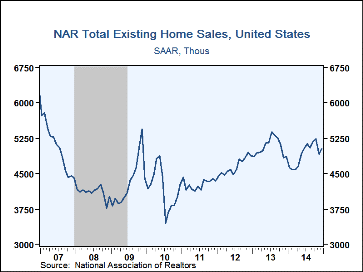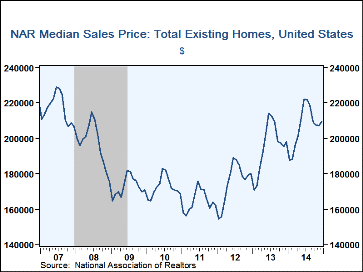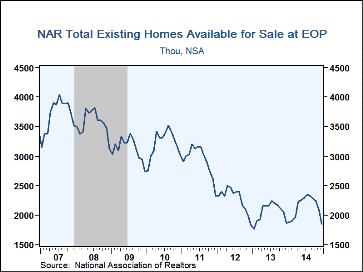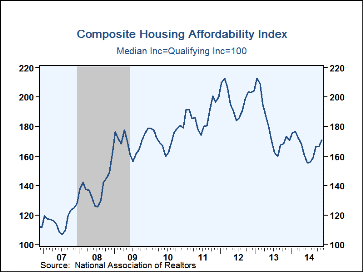 Global| Jan 23 2015
Global| Jan 23 2015U.S. Existing Home Sales Declined Last Year but Prices Improved
by:Tom Moeller
|in:Economy in Brief
Summary
Existing single-family home sales fell 3.1% during all of 2014 to 4.916 million, following three years of positive growth. For December alone, however, sales improved 2.4% month-to-month (3.5% y/y) to 5.040 million (AR) from 4.920, [...]
Existing single-family home sales fell 3.1% during all of 2014 to 4.916 million, following three years of positive growth. For December alone, however, sales improved 2.4% month-to-month (3.5% y/y) to 5.040 million (AR) from 4.920, revised from 4.930 million. December sales roughly matched consensus expectations for 5.05 million in the Action Economics Forecast Survey. Single-family home sales fell 3.2% last year to 4.328 million but rose 3.5% (4.0% y/y) in December. Condo and co-op sales improved 22.3% in 2014 to 2.140 million, gaining 3.5% (4.0% in December.
The median sales price of an existing home increased 5.7% last year to $206,808, the third straight year of increase. Prices improved further to $209,500 (6.0% y/y) in December from November's $207,500, revised from 205,300. The latest increase followed five consecutive months of decline. The median price gained 0.8% (3.7% y/y), also following five straight months of decline.
By region, sales in the West declined 7.5% during all of last year then rebounded 9.8% (2.8% y/y) to 1.120 million in December. Sales in the South gained 0.7% last year then 3.8% (7.4% y/y) in December to 2.170 million. Home sales in the Midwest declined 5.4% last year to 1.128 million and then fell 3.5% (-2.7% y/y) in December to 1.090. Sales in the Northeast declined 2.9% last year then another 2.9% (+3.1% y/y) to 660,000 last month.
The inventory of unsold homes fell 0.5% y/y to 1.850 million, its lowest point since January. Compared to sales, the supply of unsold homes fell sharply to 4.4 months by the end of the year. That compares to an 11.9-month peak supply in July of 2010.
During November, home affordability improved 2.6% (-1.5% y/y). Monthly mortgage payments fell to 14.6% of median family income but remained down from their 2006 high of 23.2%. Mortgage interest rates dropped to 4.16% and remained below the recent high of 4.54% in January.
The data on existing home sales, prices and affordability can be found in Haver's USECON database. The regional price, affordability and inventory data are available in the REALTOR database. The expectations figure is from the Action Economics survey, reported in the AS1REPNA database.
| Existing Home Sales (SAAR, 000s) | Dec | Nov | Oct | Y/Y % | 2014 | 2013 | 2012 |
|---|---|---|---|---|---|---|---|
| Total | 5,040 | 4,920 | 5,250 | 3.5 | 4,916 | 5,073 | 4,659 |
| Northeast | 660 | 680 | 710 | 3.1 | 640 | 659 | 597 |
| Midwest | 1,090 | 1,130 | 1,240 | -2.7 | 1,128 | 1,193 | 1,064 |
| South | 2,170 | 2,090 | 2,160 | 7.4 | 2,047 | 2,032 | 1,834 |
| West | 1,120 | 1,020 | 1,140 | 2.8 | 1,101 | 1,190 | 1,164 |
| Single-Family Sales | 4,470 | 4,320 | 4,620 | 4.0 | 4,328 | 4,471 | 4,128 |
| Median Price Total ($, NSA) | 209,500 | 207,200 | 207,500 | 6.0 | 206,808 | 195,667 | 175,442 |
Tom Moeller
AuthorMore in Author Profile »Prior to joining Haver Analytics in 2000, Mr. Moeller worked as the Economist at Chancellor Capital Management from 1985 to 1999. There, he developed comprehensive economic forecasts and interpreted economic data for equity and fixed income portfolio managers. Also at Chancellor, Mr. Moeller worked as an equity analyst and was responsible for researching and rating companies in the economically sensitive automobile and housing industries for investment in Chancellor’s equity portfolio. Prior to joining Chancellor, Mr. Moeller was an Economist at Citibank from 1979 to 1984. He also analyzed pricing behavior in the metals industry for the Council on Wage and Price Stability in Washington, D.C. In 1999, Mr. Moeller received the award for most accurate forecast from the Forecasters' Club of New York. From 1990 to 1992 he was President of the New York Association for Business Economists. Mr. Moeller earned an M.B.A. in Finance from Fordham University, where he graduated in 1987. He holds a Bachelor of Arts in Economics from George Washington University.










